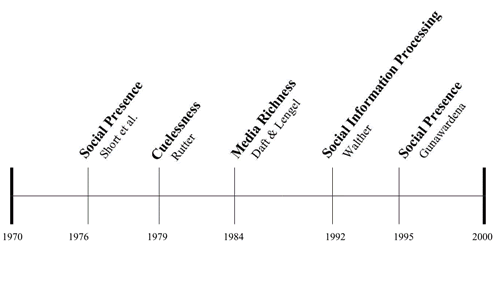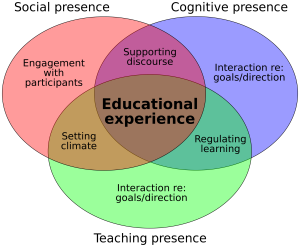What is the importance of social presence in fostering deep learning?
Excerpt from Donald, R., Gallahad, R. and Kamal, S. (2013) 𝐓𝐡𝐞 𝐈𝐦𝐩𝐨𝐫𝐭𝐚𝐧𝐜𝐞 𝐨𝐟 𝐒𝐨𝐜𝐢𝐚𝐥 𝐏𝐫𝐞𝐬𝐞𝐧𝐜𝐞 𝐢𝐧 𝐅𝐨𝐬𝐭𝐞𝐫𝐢𝐧𝐠 𝐃𝐞𝐞𝐩 𝐋𝐞𝐚𝐫𝐧𝐢𝐧𝐠 𝐢𝐧 𝐎𝐧𝐥𝐢𝐧𝐞 𝐄𝐝𝐮𝐜𝐚𝐭𝐢𝐨𝐧.
Distance education originated with correspondence courses in the 18th century, in which passive media were utilised to allow asynchronous communications between a tutor and a learner. With the introduction of the Web in 1994, allowing increased public access to digital resources, the opportunities for online education opened up. Technological developments opened various possibilities for interaction, virtual learning communities were enabled to move beyond only web-based activities, and interaction began to be viewed as an essential element in online courses.
Now, education has been regarded as a social practice, and consequently, it was considered that any formal learning environment should provide for the social practice and process of learning. However, in the case of asynchronous text-based environments, computer-mediated communication (CMC) was soon criticized from the perspective that the loss of cues normally used in social interaction would interfere with learning, and that the lack of face-to-face interaction in web-based learning made it less effective than traditional classroom learning.
Therefore, it became a focus of inquiry as to how online education can cater to the social requirement, and research began on how online course participants interact. Garrison (2011) regards this as the best place to begin thinking about e-learning, due to the medium’s ability to support levels of interactivity at a high level. As research began on interactions in e-learning, questions arose as to the degree to which social cues being filtered out in CMC determined how participants interact socially and are perceived as “being there” and able to come across as being “real” when communicating online.
Cui et al (2012) suggest that among the many factors that affect the online learning experience, social presence is worthy of extended study in terms of the asynchronous nature of web-based education and the communication issues that it raises. Social presence is arguably the most popular theory used to evaluate how participants socially interact in virtual learning environments (VLE). According to Cui et al (2012), social presence is an essential starting point for research on how students feel about their online experience, primarily in consideration of “students’ frustration, dissatisfaction, less participation or even higher dropout rates” that may result from asynchronous learning environments. Social presence should also be considered with regard to the effectiveness of online instruction.
So, we must ask, what is meant by social presence? There is no single, universally accepted definition, and almost all who use the term give a slightly different definition. Social presence has been variously defined as:
- the degree to which individuals perceive intimacy, immediacy, and their particular role in a relationship (Short, Williams, and Christie, 1976)
- the feeling of contact obtained across various communication media (Williams, 1978)
- the degree of feeling, perception, and reaction of being connected by CMC to another intellectual entity through a text-based encounter (Tu & McIsaac, 2002)
- a student’s sense of being in and belonging in a course and the ability to interact with other students and an instructor (Picciano, 2002)
- the ability of participants to identify with a group, communicate purposefully in a trusting environment, and develop personal and affective relationships progressively by way of projecting their individual personalities (Garrison, 2009)
Lowenthal highlights that the various definitions tend to fall on a continuum, on one end of which social presence is conceptualized as the degree to which a participant is perceived as being “real” and being “there”. The focus of these definitions is on whether people can project themselves as being “real” in an online environment. At the other end of the continuum, the focus is not only on whether someone is perceived as being “real”, but on whether there is a positive “interpersonal emotional connection” between participants. Lowenthal concludes that most researchers fall in the middle of the continuum.

Social presence can be demonstrated to be of importance on two levels, both of which are essential in community building and guiding learner–learner interaction to deeper levels of understanding, which Motteram (2001) perceives as being vital in the educational process.
Salmon (2011) applies the term ‘socialisation’ to the second stage of her five-step model of the online learning experience, and this can be related to the first level of social presence. We have previously considered social presence in terms of presenting ourselves as being “real”, and this extends to perceiving other participants as being “real” and “there” also, to the point that relationships can be formed. Salmon presents her second stage as one of “individual participants establishing their online identities and then finding others with whom to interact.”

Therefore it has been advised that online tutors begin their courses by encouraging students to share general, personal information, and Anderson (2004) suggests that this is best achieved through the use of virtual icebreakers. These activities enable participants to project their personal characteristics into the community, thereby presenting themselves to the other participants as ‘real’ people and making all feel that they belong to the group. This sense of belonging or presence’ enables students to interact comfortably with peers as well as instructors.
Now, these directions toward a social experience extend beyond that of simply creating a friendly atmosphere such that participants enjoy a course and form new friendships (although these are important motivating factors). Socialisation is not employed blindly to facilitate chat, but exists as a developmental stage towards deeper interaction for pedagogical reasons. Salmon’s model indicates that successful socialisation (stage 2) leads participants on to information exchange (stage 3) and knowledge construction (stage 4), which takes us beyond surface communications to more critical discourse.
The idea of social presence reducing personal risk and increasing acceptance becomes particularly important in critical discourse as, according to Garrison and Anderson (2011), the establishment of social presence also enhances and sustains cognitive presence. Garrison and Anderson argue that a successful education depends upon a balance of social, cognitive, and instructor presence as a foundation for a critical and creative ‘community of inquiry’, which is a requisite for higher learning.
Such a “true learning community”, according to Belderrain (2006), places student interaction “at the heart of learner-centred constructivist” practice, “fostering student interaction” and “promoting collaboration”. Lowenthal (2009) adds that the community of inquiry model is “based on assumptions about participation,” stemming from “evidence of learners reaching higher levels of cognitive engagement as they work with others in their community, supported by teacher activity which enhances the conditions for such interaction.”
So, this focus on a community again highlights the importance of social presence in developing interaction and collaboration and indicates that the quality and quantity of interaction can be molded by the degree of social presence (Belderrain, 2006). The community-centred approach allows for the inclusion of a critical social component and permits us to investigate how learners can create new knowledge collaboratively, which is at the heart of social constructivism.
In summary, social presence entails establishing a community of practice in which members “support and challenge each other, leading to effective knowledge construction” (Anderson, 2004), and “successful e-learning depends on the ability of the educator to create learning environments that motivate students and facilitate meaningful and worthwhile learning activities” (Garrison & Anderson, 2011). Social presence “[empowers] participants to actively construct their knowledge rather than passively receiving information, through participation in reflective dialogue in a trusting, familiar, informal and empathic community” (Chapman et al, 2005).

So much for the theory … let’s experience it in practice …
“I felt so inspired by this course, which I learned so much from. It gave me a better perception of online teaching.”
Margo in South Africa
If you think ‘teaching online’ just means live lessons in a virtual classroom or Zoom, then get ready to think again!
Our comprehensive course on effective Online Course Delivery is now enrolling. Designed by industry experts with years of experience in online education, this course is tailored to help you develop and deliver effective, engaging online courses that inspire your learners and foster their success.
In this course, you will learn:
- The principles of effective online course delivery
- How to develop clear and measurable learning outcomes
- Strategies for engaging and motivating your learners
- How to design effective assessments and evaluations
- Tips for creating interactive and multimedia-rich content
- Techniques for promoting learner interaction and collaboration
- Best practices for managing online discussions and feedback
Our course is designed for educators and course creators of all levels, from beginners to experienced professionals. With a mix of online lectures, interactive activities, and real-world examples, you’ll gain the skills and confidence you need to create courses that truly make an impact.
Don’t miss out on this opportunity to take your online courses to the next level!
Enroll now and start delivering effective, engaging online courses that inspire your learners and drive their success!
Course length, dates & times
This 35-hour course is delivered over 5 weeks. There will be a weekly 1-hour live session, the timing of which will be negotiated per the availability of the group.
Apart from the live session, much of the interaction takes place in online forums. Participants can log in and work through each unit at any time during the week.
!! SPECIAL OFFERS !!
Book Online Course Delivery + Teaching Business English
and get £33 off the standard price
Register Now …
”I enjoyed Online Course Delivery immensely. The training provider has designed a detailed course that gives fantastic value for money, incorporating both individual and group forms of communication and tasks. The course has given me the knowledge and tools to further my career teaching online. I can highly recommend Online Course Delivery.”
Matt in Brazil
REFERENCES
Ally, M. (2004) Foundations of educational theory for online learning. In T. Anderson and F.Elloumi (eds) Theory and
Practice of Online Learning. Athabasca, AB: AU Press.
Anderson, T. (2004) Toward a theory of online learning, In Anderson, T. and Elloumi, F. (eds) Theory and Practice of
Online Learning. Athabasca, AB: AU Press.
Beaudoin, M.F. (2002) Learning or Lurking? Tracking the ‘invisible’ online student. Internet and Higher Education, 5, 147-
155.
Belderrain, Y. (2006) Distance Education Trends: Integrating new technologies to foster student interaction and
collaboration. Distance Education, 27(2), 139-153.
Chapman, C., Ramondt, L. & Smiley, G. (2005) Strong community, deep learning: exploring the link. Innovations in
Education and Teaching International, 42(3), 217–230.
Chou, C. (2002) A comparative content analysis of student interaction in synchronous and asynchronous learning
networks. Proceedings of the 35th Hawaii International Conference on System Sciences. Retrieved
from: http://courseweb.stthomas.edu/ccchou/triennial/Publications/HICSS35.pdf
Coxhead, A. (2000) A new academic word list. TESOL Quarterly, 34, 213–238.
Cui, G., Lockee, B. and Meng, C. (2012) Building modern online social presence: A review of social presence theory and
its instructional design implications for future trends. Education and Information Technologies, published online in March.
Garrison, D. and Cleveland-Innes, M. (2005): Facilitating Cognitive Presence in Online Learning: Interaction Is Not
Enough. American Journal of Distance Education, 19(3), 133-148.
Garrison, D. and Anderson, T. (2011) E-Learning in the 21st Century: A Framework for Research and Practice (2nd
Edition). London: Taylor & Francis.
Hammond, M. (1999) Issues associated with participation in online forums – the case of the communicative learner.
Education and Information Technologies, 4(4), 353-367.
Haythornthwaite, C. (2002) Building Social Networks via Computer Networks: Creating and Sustaining Distributed
Learning Communities. In Building Virtual Communities: Learning and Change in Cyberspace, K.A. Renninger and W.
Schumar (eds). Cambridge: Cambridge University Press.
Hillman, D.C., Willis, D.J. and Gunawardena, C.N. (1994) Learner-interface interaction in distance education: An
extension of contemporary models and strategies for practitioners. The American Journal of Distance Education, 8(2),
30-42.
Hrastinski, S. (2008) Asynchronous and Synchronous E-learning. Educause Quarterly, 4, 51-55.
Hrastinski, S. (2008b) The potential of synchronous communication to enhance participation in online discussions: A
case study of two e-learning courses. Information and Management, 45(2), 499-506.
Kear, K. (2011) Online and Social Networking Communities: a best practice guide for educators. Abingdon: Routledge.
Koch, N. (2005) Media Richness or Media Naturalness? The Evolution of our Biological Communication Apparatus and
Its Influence on our Behavior Toward E-Communication Tools. IEEE Transactions on Professional Communication, 48(2),
117-130.
Lowenthal, P. R. (2009). The evolution and influence of social presence theory on online learning. In T. T. Kidd (Ed.)
Online education and adult learning: New frontiers for teaching practices. Hershey, PA: IGI Global.
Martin, F., Parker, M.A. and Deale, D.F. (2012) Examining interactivity in synchronous virtual classrooms. The
International Review of Research in Open and Distance Learning, 13(3), 228-261. Available at:
http://www.irrodl.org/index.php/irrodl/article/view/1174/2253. Date accessed: April 2013.
McConnell, D. (2006) E-learning groups and communities. Open University Press: Maidenhead.
Moore, M.G. (1989) Editorial: Three types of interaction. The American Journal of Distance Education, 3(2), 1-7.
Moore, M. and Kearsley, G. (2005). Distance Education: A Systems View (2nd ed.). Belmont, CA: Wadsworth.
Motteram, G. (2001) The role of synchronous communication in full distance education. Australian Journal of
Educational Technology, 17(2), 131-149.
Picciano, A. (2002) Beyond student perceptions: issues of interaction, presence, and performance in an online course.
Journal of Asynchronous Learning Networks, 6(1), 21-40.
Richardson, J. and Swan, K. (2003) Examining social presence in online courses in relation to students’ perceived
learning and satisfaction. Journal of Asynchronous Learning Networks, 7(1), 68-88.
Oztok, M., Zingaro, D., Brett, C. and Hewitt, J. (2013) Exploring asynchronous and synchronous tool use in online
courses. Computers and Education, 60(1), 87-94.
Park, Y.J. and Bonk, C.J. (2007) Synchronous Learning Experiences: Distance and Residential Learners’ Perspectives in
a Blended Graduate Course. Journal of Interactive Online Learning, 6(3), 245-262.
Pennebaker, J., Chung, C., Ireland, M., Gonzales, A., and Booth, R. (2007) The development and psychometric
properties of liwc 2007. Available at: http://www.liwc.net/howliwcworks.php. Date accessed: April 2013.
Robert, L. P. and Dennis, A. R. (2005) Paradox of Richness: A Cognitive Model of Media Choice. IEEE Transactions on
Professional Communication, 48(1), 10-21.
Salmon, G. (2011) E-moderating – The Key to Teaching and Learning Online (3rd Edition). London: Taylor & Francis.
Schrum, L. and Hong, S. (2002) From the field: characteristics of successful tertiary online students and strategies of
experienced online educators. Education and Information Technologies, 7(1), 5-16.
Sutton, L.A., (2001) The Principle of Vicarious Interaction in Computer-Mediated Communications. International Journal
of Educational Telecommunications, 7(3), 223–242.
Swan (2002) Building Learning Communities in Online Courses: the importance of interaction. Education,
Communication and Information, 2(1): 23-49.
Vonderwell, S. (2003) An examination of asynchronous communication experiences and perspectives of students in an
online course: a case study. The Internet and Higher Education, 6(1), 77-90.
Wegerif, R. (1998) The social dimension of asynchronous learning networks, Journal of Asynchronous Learning
Networks, 2(1).
White, C. (2005) The contribution of distance education to the development of individual learners. Distance Education,
26(2), 165-181.




